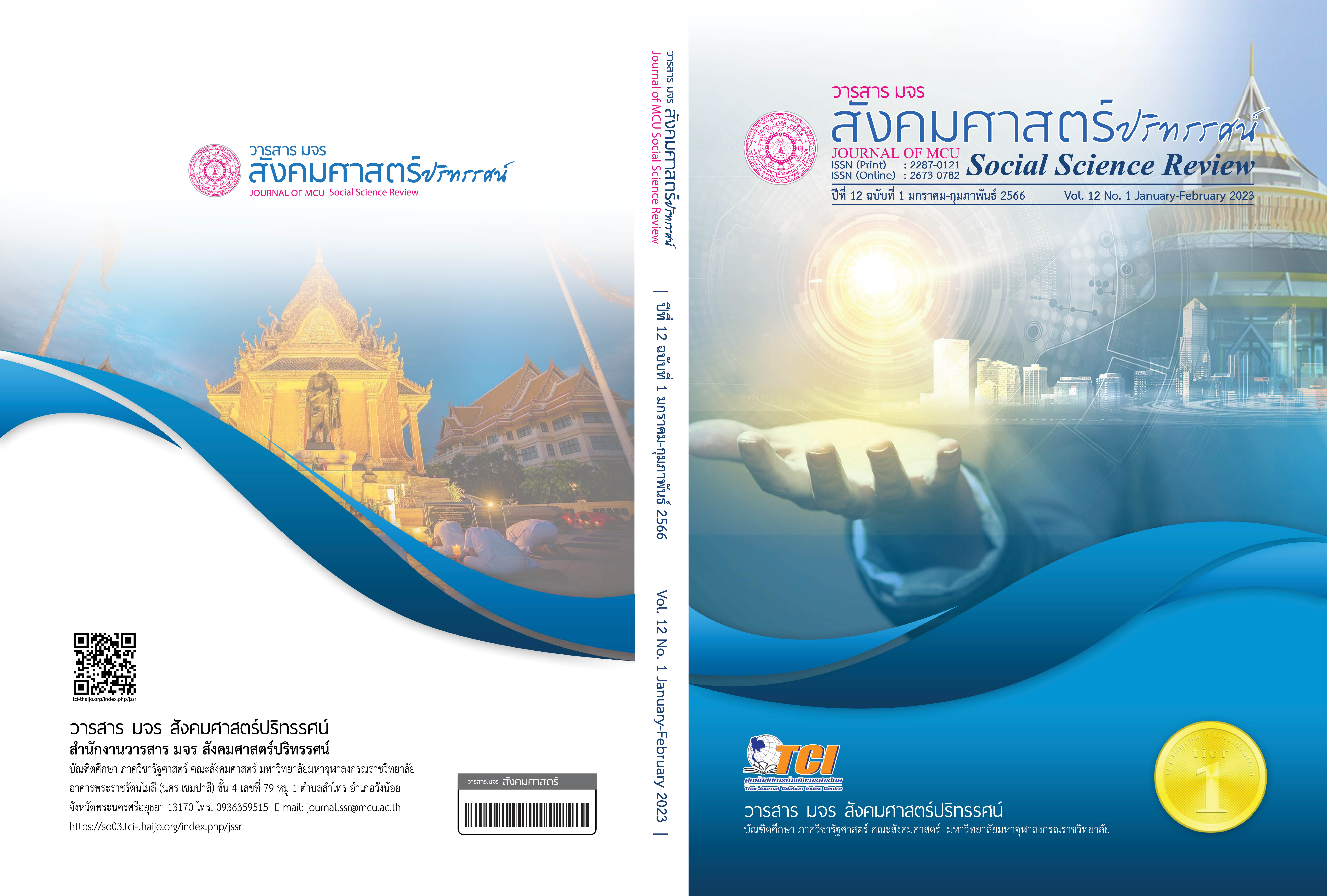การพัฒนาโครงสร้างเชิงระบบเพื่อการปกครองคณะสงฆ์ที่เข้มแข็งในสังคมไทย
คำสำคัญ:
การพัฒนา, โครงสร้างเชิงระบบ, การปกครองคณะสงฆ์บทคัดย่อ
บทความวิจัยนี้มีวัตถุประสงค์เพื่อสังเคราะห์กฎหมายสำหรับการปกครองคณะสงฆ์ศึกษาศูนย์ช่วยเหลือคณะสงฆ์ด้านกฎหมายและข้อพิพาท พัฒนาระบบปฏิบัติการเชิงกฎหมายและพระธรรมวินัย และการพัฒนาเครือข่ายทางสังคมเพื่อการปกครองคณะสงฆ์ที่เข้มแข็งของคณะสงฆ์ไทย เป็นการวิจัยแบบผสมผสานของการวิจัย 4 ประเภท คือ การวิจัยเชิงเอกสาร การวิจัยเชิงปริมาณ การวิจัยเชิงคุณภาพ และการวิจัยเชิงปฏิบัติการ
ผลการวิจัยพบว่า 1. กฎหมายสำหรับการปกครองคณะสงฆ์ พบว่า แบ่งออกเป็น 2 ส่วนคือ ส่วนที่หนึ่ง เป็นกฎหมายที่เกี่ยวข้องกับการปกครองคณะสงฆ์โดยตรง และส่วนที่เป็นกฎหมายของคณะสงฆ์เกี่ยวกับพระสังฆาธิการในฐานะผู้ปกครองคณะสงฆ์ 2. แนวทางในการจัดตั้งศูนย์ช่วยเหลือคณะสงฆ์ฯ ประกอบด้วย ด้านโครงสร้างการบริหาร ด้านบทบาทหน้าที่ ด้านงบประมาณ และด้านสถานที่ตั้ง 3. แอพพลิเคชั่นฐานข้อมูลเพื่อการปกครองคณะสงฆ์ (Sangha Data Management System: SDMS) นี้ ประกอบด้วยเครื่องมืออำนวยความสะดวกให้แก่ 1. กุลบุตรผู้ประสงค์จะขอบรรพชาอุปสมบท 2. พระภิกษุและสามเณร 3. พระสังฆาธิการ 4. ผู้ดูแลระบบ ผู้ใช้งานสามารถเข้าถึงเนื้อหา กิจกรรมต่าง ๆ ได้โดยผ่านเว็บไซต์ ww.sanghadata.com 4. กลไกการพัฒนาเครือข่ายทางสังคม เริ่มต้นจากทีมนักวิจัยเข้าไปมีบทบาทในการส่งเสริมเครือข่ายทางสังคมให้มีบทบาทในการให้คำปรึกษา การให้กำลังใจ การให้ความรู้เกี่ยวกับกฎหมายกับกลุ่มเป้าหมายคือ พระภิกษุสามเณรในพื้นที่ เพื่อลดปัญหาการกระทำความผิดของพระภิกษุสามเณรในพื้นที่ และ สามารถควบคุมพระภิกษุสามเณรให้อยู่ในพระธรรมวินัย และนโยบายของคณะสงฆ์ได้ ส่งผลให้คณะสงฆ์เกิดความเข้มแข็งและยั่งยืนในการปกครอง
เอกสารอ้างอิง
ข่าวไทยพีบีเอส. (2562). จำคุก 3 ปี "เจ้าอาวาสวัดกัลยาณมิตร" ทุบโบราณสถาน. สืบค้น 25 เมษายน 2562, จาก https://news.thaipbs.or.th/content/279543
เนชั่น บรอดแคสติ้ง คอร์ปอเรชั่น. (2565). แจ้งจับเจ้าอาวาสวัดดังเมืองน่าน .ข้อหาไม่ติดป้าย เขตปลอดบุหรี่. สืบค้น 12 พฤษภาคม 2565, จาก https://www.nationtv.tv/
news/378479543
บางกอก โพสต์. (2565). ตำรวจถือหมายศาลจับพระหนีคดีมาบวชนาน 10 ปี. สืบค้น 12 พฤษภาคม 2565, จาก https://www.posttoday.com/social/local/533489
ประเวศน์ มหารัตน์สกุล. (2563). ปัจจัยการบริหารที่เกื้อหนุนการคงอยู่ของพุทธศาสนาในประเทศไทย. วารสารสังคมศาสตร์และมานุษยวิทยาเชิงพุทธ, 5(7), 273-285.
พระประจิรักษ์ มหาปญฺโญ (เมฆหมอก). (2561). การจัดทำบัญชีเพื่อการจัดการศาสนสมบัติของวัด ในอำเภอพระนครศรีอยุธยา. วารสาร มจร สังคมศาสตร์ปริทรรศน์, 7(2), 256-266.
พระวีระชาติ ธีรสิทฺโธ (เพ็งแจ่ม) และพระมหามิตร ฐิตปญฺโญ. (2562). การดำเนินชีวิตของพระสงฆ์ไทยในสังคมปัจจุบัน. วารสารธรรมทรรศน์, 19(3), 255-264.
พระสิทธินิติธาดา. (2559). สถานภาพทางกฎหมายของวัดที่มิได้รับพระราชทาน วิสุงคามสีมาและสำนักสงฆ์. วารสารรามคำแหง, 5(1), 53-81.
องค์การกระจายเสียงและแพร่ภาพสาธารณะแห่งประเทศไทย. (2565). จับผู้ก่อเหตุร่วมปล้นทอง หลังหนีคดีไปบวชกว่า 6 ปี. สืบค้น 12 พฤษภาคม 2565, จาก https://news.
thaipbs.or.th/content/293304
________. (2565). ชาวบ้านนครราชสีมา ร้องรัฐฯแก้ปัญหา "ควันเผาศพ" หลังเดือดร้อนนานว่า 20 ปี. สืบค้น 12 พฤษภาคม 2565,จากhttps://news. thaipbs.or.th/content
/172948
อาจณรงค์ พุ่มงาม (2562). เปิดแฟ้มเรื่องร้องเรียนผู้ตรวจการแผ่นดิน ทวงคืนพื้นที่โบราณสถาน. วารสารผู้ตรวจการแผ่นดิน, 12(1), 83-89.
ดาวน์โหลด
เผยแพร่แล้ว
รูปแบบการอ้างอิง
ฉบับ
ประเภทบทความ
สัญญาอนุญาต
ลิขสิทธิ์ (c) 2023 วารสาร มจร สังคมศาสตร์ปริทรรศน์

อนุญาตภายใต้เงื่อนไข Creative Commons Attribution-NonCommercial-NoDerivatives 4.0 International License.
เพื่อให้เป็นไปตามกฎหมายลิขสิทธิ์ ผู้นิพนธ์ทุกท่านต้องลงลายมือชื่อในแบบฟอร์มใบมอบลิขสิทธิ์บทความให้แก่วารสารฯ พร้อมกับบทความต้นฉบับที่ได้แก้ไขครั้งสุดท้าย นอกจากนี้ ผู้นิพนธ์ทุกท่านต้องยืนยันว่าบทความต้นฉบับที่ส่งมาตีพิมพ์นั้น ได้ส่งมาตีพิมพ์เฉพาะในวารสาร มจร สังคมศาสตร์ปริทรรศน์ เพียงแห่งเดียวเท่านั้น หากมีการใช้ภาพหรือตารางหรือเนื้อหาอื่นๆ ของผู้นิพนธ์อื่นที่ปรากฏในสิ่งตีพิมพ์อื่นมาแล้ว ผู้นิพนธ์ต้องขออนุญาตเจ้าของลิขสิทธิ์ก่อน พร้อมทั้งแสดงหนังสือที่ได้รับการยินยอมต่อบรรณาธิการ ก่อนที่บทความจะได้รับการตีพิมพ์ หากไม่เป็นไปตามข้อกำหนดเบื้องต้น ทางวารสารจะถอดบทความของท่านออกโดยไม่มีข้อยกเว้นใดๆ ทั้งสิ้น





